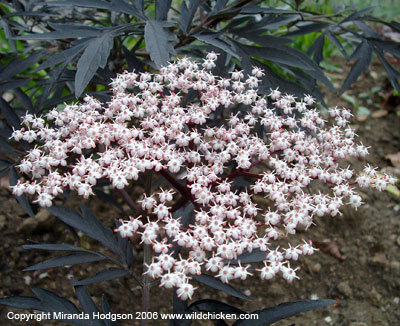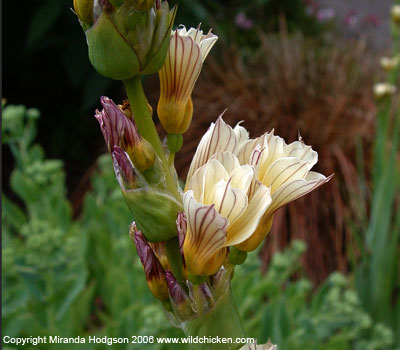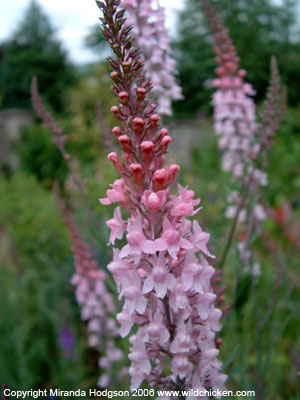23rd June 2006 - A possible remedy for chilli burns, plus summer flowers
Back in February ’05, I mentioned that I’d burned my fingers whilst tearing up dried chillies. I asked for anyone with any remedies to please let me know their ideas. Well, this week, after all this time, someone emailed to say that they’ve found something that works: soaking your fingers in cold tea. It sounds like the sort of thing that your grandmother would tell you. To quote: “The tannins in tea latch on to the same pain receptors as capsicum, and form a stronger bond than the chilli, thereby displacing it and causing the burning sensation to ease.” Apparently you get the same effect from PGTips or Earl Grey, though my correspondent did mention that, as everyone is different, the remedy may not work for all.
"After all this time, someone emailed to say that they’ve found something that works"
He also suggested trying applying rubbing alcohol to your hands before working with the chillies and then soaking them in milk afterwards, since “milk contains casein, another protein that bonds with capsaicin and displaces it from the nerve receptors”. Failing that, try citrus. Failing all, wear gloves.
The cold tea idea seems almost too simple to be real, but I shall inflict myself once more just to try it out. If it does work – and I have a hunch that it will - I’ll let you know. Looking at the website access logs, a lot of people search on ‘chilli burns’ (though all they’ve been getting from this site has been me grumbling about it), so it would be useful to be able to suggest something that actually works.
To the garden. Some of the plants that were flowering this time last month have finished their first flushes. Geum borisii will flower again in a few weeks if deadheaded, as will Geranium phaeum and Anthemis punctata subsp. cupaniana. Clematis ‘Warwickshire Rose’ has finished flowering for this year, but its place is taken by a nearby honeysuckle which is just getting going.
Nearby we are rewarded for planting a pink Escallonia (no idea what type as it came from a supermarket and had no label) by masses of flowers and their attendant bees. We’ve both noticed that the bees pay more attention to the flowers after the full sun has left them and wonder if it’s because the flowers produce more pollen then.
Elsewhere, the new elder we put in, Sambucus nigra ‘Black Lace’, has flowered for the first time and looks quite as nice as expected. The finely cut dark leaves are a perfect background for the large heads of pale pink flowers. Not having anything else handy, I under-planted it with dark blue trailing lobelia, which is just coming into flower. Trailing lobelia is a familiar summer plant, too run of the mill for some, but I think the combination works well, with the small blue flowers lighting up the ground beneath the elder foliage.

Sambucus nigra ‘Black Lace’
On the other side of the garden, in the new bed, is a plant that I’d wanted for a long time, Sisyrinchium striatum, which is also flowering. The habit is iris-like but the flowers are more trumpet-shaped. From a distance it doesn’t look like much but, when you get closer, what looked like fairly non-descript pale yellow flowers are revealed to have a lot more character - a beautiful pattern of fine dark purple lines runs down the length of the petals and the unfurled flowers show shades of purple. This effect is added to by the flowers also being tinted with rich buttery yellow at the base. These are growing in combination with bright orange Eschscholzia californica and dark purple salvias and I’m well pleased with it

Sisyrinchium striatum
Linaria purpurea has seeded itself all over the place again this year. This, too, is a very common plant, a weed for some, but I really like it and if there’s too much I can always pull it out. It’s a wonderful filler for this time of year, with fine grey-green foliage and spires of small flowers in either pink or purple. The pink flowering type has the added advantage that the unopened buds are a few shades darker than the open ones. The shades of linaria go so well with many other perennials and look divine with the flowering stems of the dark red herbaceous potentillas growing through them. The bees like it, too.

Linaria purpurea
Foxgloves are in full flower and looking gorgeous, as foxgloves always do. I’m not sure what it is exactly about them – maybe it’s because they signal the start of real summer time, or maybe it’s the sight of them in the woods, standing tall and proud above the undergrowth, that makes them so attractive, but they are the most beautiful of plants.
Last autumn, I dug up a lot of seedlings and spread them around the garden in places where I want them to self seed. Outside the kitchen window, in the shady corner under the apple tree, here and there in the front garden. In years to come, they should multiply and provide height, colour and plentiful bee food. The bees have been so busy going in and out of the flowers that many come out with white, pollen-covered heads, which looks quite odd.
This year a couple of the flower spikes looked as if they were going to be pale yellow and I was looking forward to seeing them but, once the flowers opened, they turned pink. It’s okay, but maybe better to have either one or the other.

Pink and yellow foxgloves
© Copyright Miranda Hodgson 2006